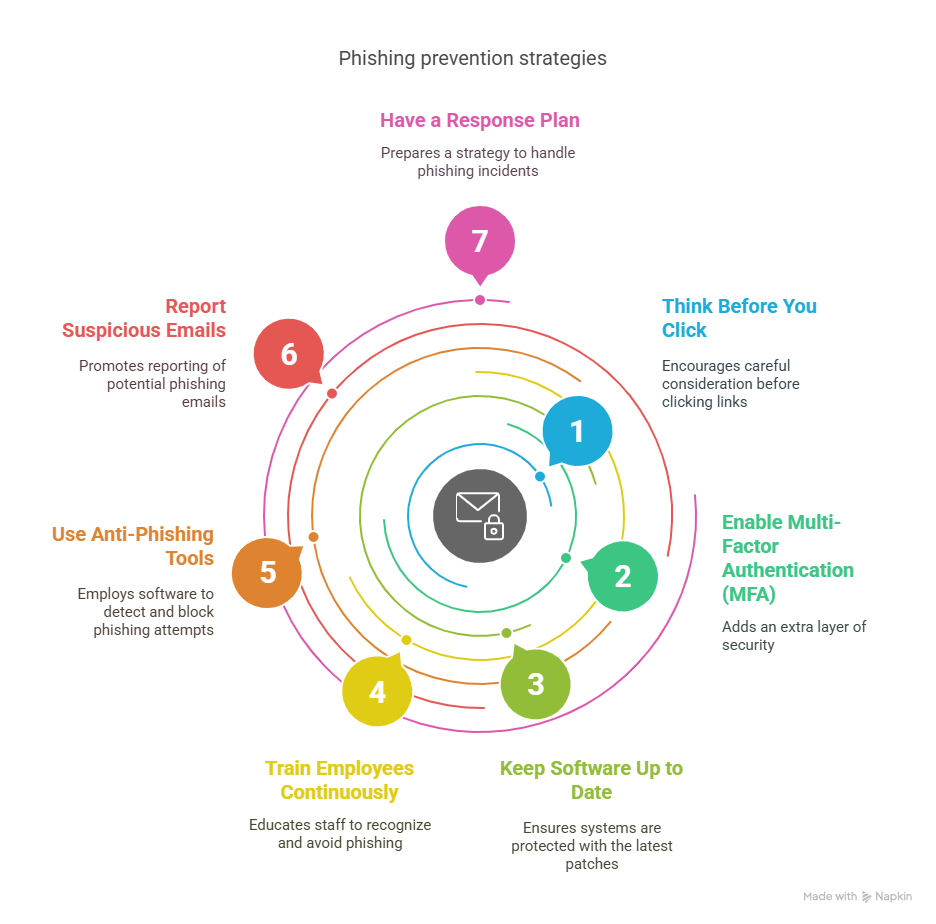When it comes to cyber threats, phishing remains one of the most widespread and effective attack methods used by cybercriminals. It’s no longer just about spam emails asking for bank details – phishing has become highly sophisticated, often disguised as internal communication, trusted services, or urgent alerts.
Whether you are an individual or an enterprise, one careless click on a malicious link can lead to data breaches, credential theft, financial fraud, or ransomware infections. According to industry reports, over 90% of cyberattacks start with a phishing email.
But the good news is: phishing is preventable. With the right knowledge, tools, and mindset, you can significantly reduce your risk exposure. PATECCO gives seven practical tips to help you recognize phishing attempts, protect your data, and foster a cyber-aware culture within your organization.

1. Think before you click
Phishing emails are designed to create urgency or curiosity – “Your account will be locked!”, “Check this invoice!”, or “Click here to claim your prize!”. Attackers rely on emotional triggers to get you to click without thinking.
Stay alert by:
- Hovering over links to preview the destination URL
- Verifying sender email addresses, even if the name looks familiar
- Being skeptical of attachments from unknown or unusual sources
2. Enable Multi-Factor Authentication (MFA)
Even the most cautious users may occasionally be tricked. That’s where MFA acts as a powerful safety net. It requires a second form of verification beyond just a password — such as a code sent to your phone, an app-based prompt, or a biometric scan.
Benefits of MFA:
- Adds a critical security layer
- Stops unauthorized access even if login credentials are stolen
- Helps organizations meet compliance requirements
3. Keep software up to date
Phishing attacks often exploit known software vulnerabilities. If your operating system, email client, or browser is outdated, you may be leaving the door open to attackers.
Best practices:
- Enable automatic updates where possible
- Prioritize patches for security-critical applications
- Regularly update antivirus and anti-malware definitions
4. Train employees continuously
Human error is the #1 vulnerability in cybersecurity. One uninformed employee can unknowingly compromise an entire network.
Make security awareness part of your culture:
- Run phishing simulations to test and educate
- Offer short, engaging, and ongoing training sessions
- Emphasize that everyone plays a role in protecting the organization
5. Use anti-phishing tools
Technology can assist your defense. Many security solutions use AI and threat intelligence to detect phishing attempts before they reach end users.
Key tools to consider:
- Email security gateways that flag or block suspicious emails
- Browser extensions that detect malicious sites
- DNS filtering tools that stop users from reaching harmful domains
6. Report suspicious Emails
Creating a culture of reporting is just as important as detection. Promptly reporting phishing emails helps security teams act fast, prevent spread, and analyze threats.
Encourage users to:
- Never delete a suspicious message immediately – report it first
- Use a designated button or contact to flag questionable emails
- Understand that early reporting protects everyone
7. Have a response plan
Despite all precautions, no system is 100% immune. Having an incident response plan ensures you can react quickly and minimize damage if a phishing attack succeeds.
Include in your plan:
- A clear communication chain and responsibilities
- Containment and recovery procedures
- Legal, compliance, and customer notification protocols
Key Takeawas
Phishing is no longer just a personal threat – it’s a strategic attack vector targeting organizations of all sizes. As attackers become more refined, defenders must become more resilient. By fostering a culture of cybersecurity vigilance, training your team regularly, and implementing layered security measures – from email filters to multi-factor authentication – you significantly reduce the risk of falling victim.
Remember: it only takes one click to compromise your entire network, but it also only takes one moment of caution to stop an attack in its tracks. Stay alert, stay informed, and keep phishing threats at bay – a proactive approach today means fewer breaches tomorrow.
Looking to assess your organization’s phishing risk or implement advanced protection? Let our IAM and cybersecurity experts help you design a stronger, smarter defense.
